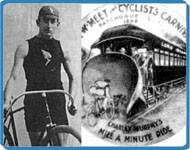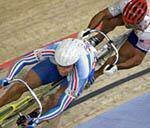|
Every cyclist has to overcome wind resistance. Most recreational cycles in which the rider sits up have very poor aerodynamics. While newer cycles are being designed with better aerodynamics in mind, the human body is simply not well designed to slice through the air. Cycle racers are aware of the problem of wind resistance and over the years have developed techniques for reducing it. Cycle designers and inventors have experimented in developing alternative cycle designs and HPVs (human- powered vehicles) with an emphasis on better aerodynamic performance.
Wind Resistance
Every cyclist who has ever pedaled into a stiff headwind knows about wind resistance. It's exhausting! In order to move forward, the cyclist must push through the mass of air in front of them. This takes energy. Aerodynmaic efficiency - a streamlined shape that cuts through the air more smoothly - enables a cyclist to travel much faster, with less effort. But the faster the cyclist goes, the more wind resistance he experiences, and the more energy he must exert to overcome it. When racing cyclists aim to reach high speeds, they focus not only on greater power, which has its human limitations, but also on greater aerodynamic efficiency.
Aerodynamic drag consists of two forces: air pressure drag and direct friction (also known as surface friction or skin friction). A blunt, irregular object disturbs the air flowing around it, forcing the air to separate from the object's surface. Low pressure regions from behind the object result in a pressure drag against the object. With high pressure in the front, and low pressure behind, the cyclist is literally being pulled backwards. Streamlined designs help the air close more smoothly around these bodies and reduce pressure drag. Direct friction occurs when wind comes into contact with the outer surface of the rider and the cycle. Racing cyclists often wear "skinsuits" in order to reduce direct friction. Direction friction is less of a factor than air pressure drag.
On a flat road, aerodynamic drag is by far the greatest barrier to a cyclist's speed, accounting for 70 to 90 percent of the resistance felt when pedaling. The only greater obstacle is climbing up a hill: the effort needed to pedal a bike uphill against the force of gravity far outweighs the effect of wind resistance.
Reducing resistance
Frame builders and designers have been working on creating more aerodynamically efficient designs. Some recent designs have concentrated on shifting from round tubes to oval or tear-shaped tubes. There is a delicate balancing act between maintaining a good strength-to-weight ratio while improving aerodynamic efficiency. Improvements to wheels have made perhaps the biggest impact. A standard spoked wheel has been described as an "egg beater," creating many small eddies as the tyre rotates--creating drag. Disc wheels, while generally heavier than their spoked counterparts, produce less wind drag and turbulence when they spin.
While improvements to frames and components have improved aerodynamic performance, the cyclist is the largest obstacle to dramatic improvement. The human body is not very streamlined. Body positioning is important; road cyclists use "drop bars" to allow themselves to reduce their frontal area, which helps reduce the amount of resistance they must overcome. Reducing the frontal area helps riders increase their speed and their efficiency over time. In addition to positioning, small details like clothing can also make a big difference in reducing "skin friction." Tight-fitting synthetic clothing is worn by almost every professional rider, both road and mountain. Many recreational riders are also wearing cycle clothes for the improvement in aerodynamics as well as comfort.
Drafting
Drafting is an important technique in road racing. Exploratorium Senior Scientist Paul Doherty explained, "The cyclist, as he moves through the air, produces a turbulent wake behind himself. It makes vortices. The vortices actually make a low pressure area behind the cyclist and an area of wind that moves along with the cyclist. If you're a following a cyclist and can move into the wind behind the front cyclist, you can gain an advantage. The low pressure moves you forward and the eddies push you forward."
Suprisingly drafting not only helps the cyclist following the leader, but the lead cyclist gains an advantage as well. Paul explained, "The interesting thing is by filling in her eddy you improve the front person's performance as well. So two people who are drafting can put out less energy than two individuals (who are not drafting) would covering the same distance in the same time." While the lead cyclist gains some advantage in this situation she still needs to expend much more energy than the cyclist who is following.
In road racing, cyclists group together in a pack known as the "peloton" or a pace line called an "echelon." Cyclists who are part of the group can save up to 40 percent in energy expeditures over a cyclist who is not drafting with the group. To be effective drafting, a cyclist needs to be as close as possible to the cycle in front of him. Many professional cyclists get within inches of the the cycle in front of them. The shorter the distance the larger the decrease in wind resistance.
next
|